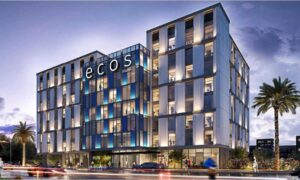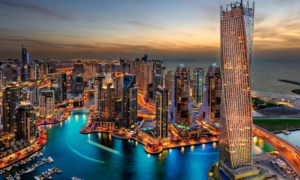Industry leaders in architecture, design, facilities, and HR management have recently gathered at the Herman Miller office in Dubai for a roundtable discussion on the complex relationship between the built environment and well-being. The panel, titled “The Power of Place: Uncovering the Link between Environment and Well-being” examined the influence of architects, designers, HR managers, and personal habits on our overall well-being.
The panel featured Laila Al Yousuf from SAY Studio, Scott Armstrong from mentl, Nuno Teixera from Bluehaus Group, Emma Davies from Masafi, Engr. John-Aziz Maalouf from Clemenceau Medical Centre, Sanjay Trisal from Fakeeh University Hospital, UAE, and Marina Mrdjen from Inteliers as the moderator.
Laila Al Yousuf: The importance of in-depth briefing stages
Laila Al Yousuf, Design Director & Partner at SAY Studio, discussed the importance of wellness and company culture in various environments, particularly post-pandemic. She emphasised the importance of taking time during the briefing and concept development stages of a project to understand how a space will function and meet the needs of the people using it: “The briefing process may span just two or three weeks, but its effects can be felt for five to ten years. To truly grasp its functioning, it’s crucial to have a comprehensive understanding of the users’ needs within the space and how to optimize their experience compared to their previous environment.”
She shared her experience working on the first WELL Platinum project in the region, PwC, and how it impacted employees’ lives: “The WELL aspect takes into consideration nutritional values, access to water, and active furnishings within a space, offering a holistic approach to an individual’s well-being, from their mind and body to their interactions with others and the community. This comprehensive focus then extends into their personal lives, fostering a sense of balance and wellness.”
Al Yousuf emphasised that when companies invest in their employee’s well-being, it sends a powerful message that they are valued and respected as individuals.
Sanjay Trisal, Chief Human Resources Officer at Fakeeh University Hospital, UAE, highlighted the significance of the workplace environment, stating, “For me, some key takeaways include recognising the importance of wellness and well-being, not just in isolation but also in connection with the facilities we work in.”
On the subject of mental well-being, Sanjay noted, “Sometimes, mental well-being can be a taboo topic depending on the cultures you work with. Not everyone comes forward if they face an issue, so we have to ensure that there are both formal and informal ways of encouraging people to step forward and address the issues they face regarding their mental well-being.”
Discussing the FUH’s design, Sanjay shared, “Our atrium facility features a cafe, a restaurant, and extensive open spaces, including a piano for anyone to play. Patients, their families, and employees can visit the atrium to unwind and alleviate stress. The atrium boasts a green wall with real plants, which, combined with the music, creates a soothing atmosphere. Open spaces naturally have a calming effect.”
By concentrating on the four pillars of well-being and incorporating them into facility design, Sanjay Trisal believes that organisations can cultivate a healthier and more productive work environment for their employees.
Scott Armstrong, CEO & Founder of mentl, emphasized that employee well-being should be integrated into the entire design process: “Employee well-being isn’t something off on the side; it actually needs to be designed into the whole process now.”
Armstrong cited studies showing that engaged employees can increase productivity and profitability by 8-20%. However, he also highlighted the risks of disengagement: “Here in the UAE, according to Gallup’s latest study, we’re losing $1.175 million an hour through disengaged employees.” He argued that investing in well-being can yield significant returns: “For every dollar we invest in this space of well-being, you get $4 back.”
He also highlighted the connection between well-designed spaces and company success: “If we are designing spaces and offices that reflect the company culture and values, amplifying them, then productivity science tells us the benefits of this approach lead to increased engagement and ultimately more revenue.”
Emma Davies, Chief people, and culture excellence officer at Masafi, emphasized the importance of listening to people when designing workspaces, as it leads to a more inclusive environment. “Your culture is what you live and breathe, and how you are. If you’ve got an awful office, I do think it has a real detrimental effect on your culture. Actually, if you have people in dark, enclosed spaces and wonder why you’re not getting creativity, there’s so much research around why that doesn’t work.”
Davies shared her experience of removing physical barriers, like glass partitions, to promote communication between employees. She mentioned an “Inspiration Station” designed with input from employees, which has resulted in increased interaction and idea-sharing across departments. “We started listening to people. We made it better for people to come to work and made it a better place to be.”
For Davies, an open-door policy is more about approachability and genuine listening than physical spaces: “Policy isn’t about doors. It’s about being and feeling and listening to your people.” She believes that office design should prioritise employees’ working styles and preferences rather than job titles and should involve continuous feedback to ensure everyone feels heard and valued.
Engr. John-Aziz Maalouf, Director of Facility & Clinical Engineering at Clemenceau Medical Centre, discussed the importance of designing spaces for both patients and staff in a hospital setting, explaining that even small changes, such as creating staff pantries, can have a significant impact on well-being. “The good thing is what we’ve done here very well is the patients’ space and the staff pantries. I mean this was a very small but very significant aspect of the design,” he added.
John shared an anecdote about an impromptu decision to create an open nurse station, which improved the flow and feeling of comfort in the space. “You walk into the lobby, you have natural light, and the nurse station is on your right. You might as well just have a completely open space. So, one big central station that can oversee most patient areas and then little places to touch base on the side. So that was one of the best decisions we made,” he concluded.
By incorporating mental health and well-being into the design process, John-Aziz Maalouf believes that organisations can create spaces that encourage better communication, collaboration, and overall employee satisfaction.
Nuno Teixera: Designing Spaces for People and Social Interaction
Nuno Teixera, Head of Architecture at Bluehaus Group, shared his insights on the importance of designing spaces that cater to the needs of the people who use them. He emphasised that input from various perspectives, such as HR and facilities operators, is essential in the design process.
Teixera explained the importance of understanding a company’s culture and vision when designing spaces: “More and more talking with the client is fundamental to understand not only the company culture but also the people.” He provided an example of a project in Kuwait where they spent four months interviewing stakeholders, students, and staff to align the design with the company’s vision and the users’ needs.
He stressed the significance of promoting social interaction in workspaces: “You spend most of your day at work, so it’s important that you also know people because you’re a social being.” Teixera described creating open spaces with no corridors, designing a large staircase to encourage movement, and fostering a sense of community within the building.
Teixera also highlighted the importance of natural light and acoustics in creating a comfortable environment: “It’s a combination between performance of light and also moods of light. Peace and quiet is important.” He emphasised that these factors contribute to both the performance and mood of the people using the space.
Herman Miller workspace solutions: A designer’s day of discovery
As part of the Herman Miller Health & Well-being Summit 2023, six interior designers from Dubai-based studios —Vince Palapal from Broadway Interiors, Nemanja Ribic from Bluehaus Group, Noura Khater from Swiss Bureau Interior Design, Ibrahim Alamassi from EHS, Regina Mathew from Allen Architecture Interiors Design, and Emanuel Marreiros from Summertown Interiors—spent a full day exploring Herman Miller’s latest workspace solutions at their office.
This immersive experience allowed them to understand the impact of different settings on productivity and comfort in modern workplaces while providing valuable user feedback.
The day kicked off with breakfast followed by the above-mentioned panel discussion. The designers then worked from various locations within the office, experiencing firsthand the benefits of well-designed workspaces.
A “lunch and learn” session with Herman Miller’s team offered insights into health, well-being, and best practices for creating healthier spaces. Afterward, they continued to explore different environments within the office.
The day wrapped up with a sound healing session, emphasizing the importance of well-being, and offering a chance to reflect on the day’s experiences.



























